How to Learn German by Yourself: 10 Proven Strategies

Written by
Ernest Bio Bogore

Reviewed by
Ibrahim Litinine

Learning German independently unlocks a wealth of opportunities. Germany's economic prominence in Europe makes it a magnet for international professionals, while mastering the language connects you with over 135 million German speakers worldwide. Though German's complex grammar and irregular verbs might seem intimidating initially, strategic self-learning methods can make the process both efficient and enjoyable.
This comprehensive guide breaks down eight evidence-based strategies to master German on your own terms, with actionable insights for beginners to advanced learners.
1. Establish Concrete Goals and a Structured Learning Plan
Effective language acquisition depends on clarity of purpose and consistency of practice.
Assess Your Current German Proficiency
Before embarking on your German learning journey, conduct a thorough assessment of your existing knowledge. Various online placement tests can accurately determine whether you're starting from scratch or have foundational skills to build upon. This baseline measurement provides the essential starting point for tracking your progress.
Craft SMART Language Goals
Vague aspirations like "becoming fluent in German" lack the specificity needed for sustained motivation. Instead, formulate goals following the SMART framework:
- I will learn and retain 30 new German words weekly for the next three months
- I plan to achieve B1 certification within nine months of dedicated study
- By September, I will be able to conduct a 15-minute conversation about my professional background entirely in German
Develop a Realistic Study Regimen
Analyze your weekly schedule and identify consistent time blocks you can dedicate to German study. Research demonstrates that daily practice of 20-40 minutes is more effective than sporadic longer sessions. Create a balanced routine that includes all four language competencies:
- Reading comprehension
- Writing practice
- Listening exercises
- Speaking opportunities
Incorporate your personal interests into your learning activities to maintain engagement. If you enjoy cooking, try following German recipes; if you're a film enthusiast, watch German cinema with subtitles.
2. Master German Phonetics and Alphabet Fundamentals
Developing proper pronunciation early prevents the formation of difficult-to-break habits later.
Navigate the Unique German Vowels
The German umlauts (ä, ö, ü) represent distinct sounds that significantly alter word meanings:
- "ä" approximates the vowel sound in the English word "fair"
- "ö" resembles the "e" in "her," but with rounded lips
- "ü" requires pronouncing "ee" while simultaneously rounding your lips forward
Investing time in mastering these sounds pays dividends throughout your language journey, as proper pronunciation affects both comprehension and being understood.
Understand the Eszett (ß)
The distinctive Eszett (ß) represents a sharp "s" sound, similar to the double "s" in English "hiss." Though modern German spelling reforms have reduced its usage in favor of "ss" in some contexts, this character remains prevalent in contemporary German writing.
Develop Authentic Pronunciation Habits
Pronunciation practice should include:
- Listening to native speakers through podcasts and videos
- Recording yourself and comparing with authentic examples
- Focusing on problematic sounds specific to English speakers, such as the German "r" and "ch"
3. Build a Functional German Vocabulary Base
Strategic vocabulary acquisition accelerates practical language use.
Focus on High-Frequency Word Lists
Begin with the words that German speakers use most often in daily conversation. Linguistic analysis shows that knowing just 1,000 strategically selected words enables understanding approximately 80% of everyday German conversations. Prioritize:
- Essential verbs (sein, haben, gehen, machen)
- Common nouns for everyday objects
- Basic adjectives for descriptions
- Numbers and time expressions
- Question words and conversation connectors
Implement Effective Vocabulary Learning Methods
Research in cognitive science points to several superior vocabulary retention techniques:
- Contextual learning (words in sentences rather than isolation)
- Spaced repetition systems that present words at optimal intervals
- Association techniques linking new German words with mental images
- Word family grouping to understand related terms simultaneously
Digital flashcard applications utilizing spaced repetition algorithms can significantly enhance retention compared to traditional study methods.
4. Grasp Essential German Grammatical Structures
Understanding fundamental patterns allows you to construct countless sentences independently.
Focus on Structural Cornerstones
German grammar can be systematically approached by mastering key elements:
- The four cases (nominative, accusative, dative, genitive) and their functions
- Article declension patterns according to gender, number, and case
- Verb conjugation principles across tenses
- Word order rules for main clauses versus subordinate clauses
Rather than memorizing endless exceptions initially, concentrate on the regular patterns that form the foundation of German sentence construction.
Apply Grammar in Practical Contexts
Abstract grammar knowledge transforms into practical skill through application:
- Complete targeted exercises that isolate specific grammatical concepts
- Write short paragraphs implementing newly learned structures
- Analyze authentic German texts to identify grammatical patterns in context
- Create your own example sentences with new grammar points
Resources like grammar workbooks with answer keys provide immediate feedback on your understanding without requiring external assistance.
5. Develop Conversational Skills Through Deliberate Practice
Speaking proficiency demands consistent verbal production, even without conversation partners.
Maximize Self-Directed Speaking Opportunities
While finding German conversation partners is ideal, numerous independent practice methods exist:
- Shadowing audio recordings by repeating phrases immediately after hearing them
- Describing your daily activities aloud in German
- Reading German texts with proper pronunciation
- Responding to hypothetical conversation prompts
- Using voice recognition software for pronunciation feedback
Locate Quality Conversation Partners
When ready for interactive practice, several approaches can connect you with German speakers:
- Language exchange platforms matching German natives learning your language
- Virtual meetup groups organized around German practice
- Community college courses or local cultural organizations
- Professional tutoring services for structured conversation practice
Prepare specific conversation topics before each exchange to maximize productive speaking time.
6. Immerse Yourself in Authentic German Content
Surrounding yourself with German media accelerates unconscious language acquisition.
Leverage German Audio Resources
Regular exposure to spoken German trains your ear to natural speech patterns:
- Beginner podcasts designed specifically for German learners
- News broadcasts in simplified German (Langsam gesprochene Nachrichten)
- German music with lyrics to follow alongside
- Audiobooks of familiar stories
Begin with content matching your comprehension level, gradually advancing to authentic native materials as your skills improve.
Incorporate German Reading Materials
Regular reading dramatically expands vocabulary while reinforcing grammar:
- Graded readers designed for language learners
- Children's books with straightforward language
- German news websites with international stories you're already familiar with
- Special interest articles aligned with your hobbies
- Forums and social media in German discussing topics you enjoy
Digital reading tools allowing instant dictionary lookup significantly enhance the reading experience for language learners.
Integrate German Visual Media
Films and television provide contextual language learning with visual cues:
- Start with familiar content dubbed in German
- Use German subtitles with German audio once intermediate skills develop
- Short YouTube videos on specific topics before full-length programs
- German TV series that maintain the same characters and settings
Recommended German films and shows for various proficiency levels:
- "Lola rennt" (Run Lola Run) - fast-paced thriller with repetitive scenarios
- "Dark" - science fiction series with compelling storylines
- "Türkisch für Anfänger" - comedy series about cultural integration
7. Develop Written Expression Skills
Writing cements grammar understanding while building productive language capability.
Implement Progressive Writing Exercises
Begin with structured activities matching your proficiency:
- Complete sentence transformations practicing specific grammar points
- Write short paragraphs describing images or daily activities
- Maintain a German journal with gradually increasing complexity
- Compose emails or messages to language exchange partners
- Summarize German articles you've read to reinforce comprehension
Obtain Writing Feedback
Without a teacher, alternative feedback sources include:
- Language exchange partners willing to correct written work
- Online German forums where natives can review posts
- Digital writing assistants specifically designed for German
- Self-correction by comparing your writing with native examples
8. Systematically Review and Track Progress
Consistent reinforcement transforms short-term knowledge into permanent acquisition.
Implement Strategic Review Systems
Research on memory consolidation demonstrates that scheduled reviews significantly enhance retention:
- Schedule reviews at increasing intervals (1 day, 3 days, 1 week, 2 weeks)
- Prioritize reviewing challenging concepts before comfortable ones
- Utilize digital tools that automatically schedule reviews based on performance
- Create comprehensive review sessions covering multiple skill areas
Document Your German Learning Journey
Methodical progress tracking serves multiple purposes:
- Provides concrete evidence of improvement during motivation slumps
- Identifies specific areas needing additional attention
- Creates accountability for maintaining study consistency
- Allows adjustment of learning strategies based on results
Record metrics such as vocabulary mastered, hours studied, comprehension percentage of authentic materials, and speaking confidence levels.
9. Utilize Technology Effectively
Modern language learning technology offers unprecedented self-teaching capabilities.
Select Appropriate Digital Learning Tools
The digital landscape provides numerous specialized applications:
- Spaced repetition systems for vocabulary acquisition
- Pronunciation analysis software providing articulatory feedback
- Grammar explanation platforms with interactive exercises
- Language exchange matching services
- Authentic content libraries with comprehension supports
Evaluate tools based on evidence of effectiveness rather than entertainment value or flashy interfaces.
Create a Complementary Digital Ecosystem
Rather than relying on a single application, build a suite of tools addressing different language aspects:
- Dedicated vocabulary acquisition system
- Grammar reference and practice resource
- Listening comprehension platform
- Writing assistance tool
- Speaking practice application
Integrate these tools into your learning schedule based on your priority skill areas.
10. Maintain Long-Term Motivation
Sustained motivation ultimately determines success in independent language learning.
Implement Behavioral Psychology Principles
Research-backed motivation techniques include:
- Setting process-oriented goals (study consistency) alongside outcome goals (proficiency levels)
- Creating accountability systems with concrete consequences
- Establishing clear reward structures for achieving milestones
- Developing a learning identity as "someone who speaks German"
- Connecting with the German-speaking community for cultural motivation
Address Common Motivation Challenges
Prepare strategies for inevitable motivation fluctuations:
- Rotating learning activities when enthusiasm wanes
- Reconnecting with your foundational purpose for learning German
- Taking strategic breaks without abandoning practice entirely
- Celebrating measurable progress milestones
- Adjusting expectations during challenging learning phases
Learn Any Language with Kylian AI
Private language lessons are expensive. Paying between 15 and 50 euros per lesson isn’t realistic for most people—especially when dozens of sessions are needed to see real progress.
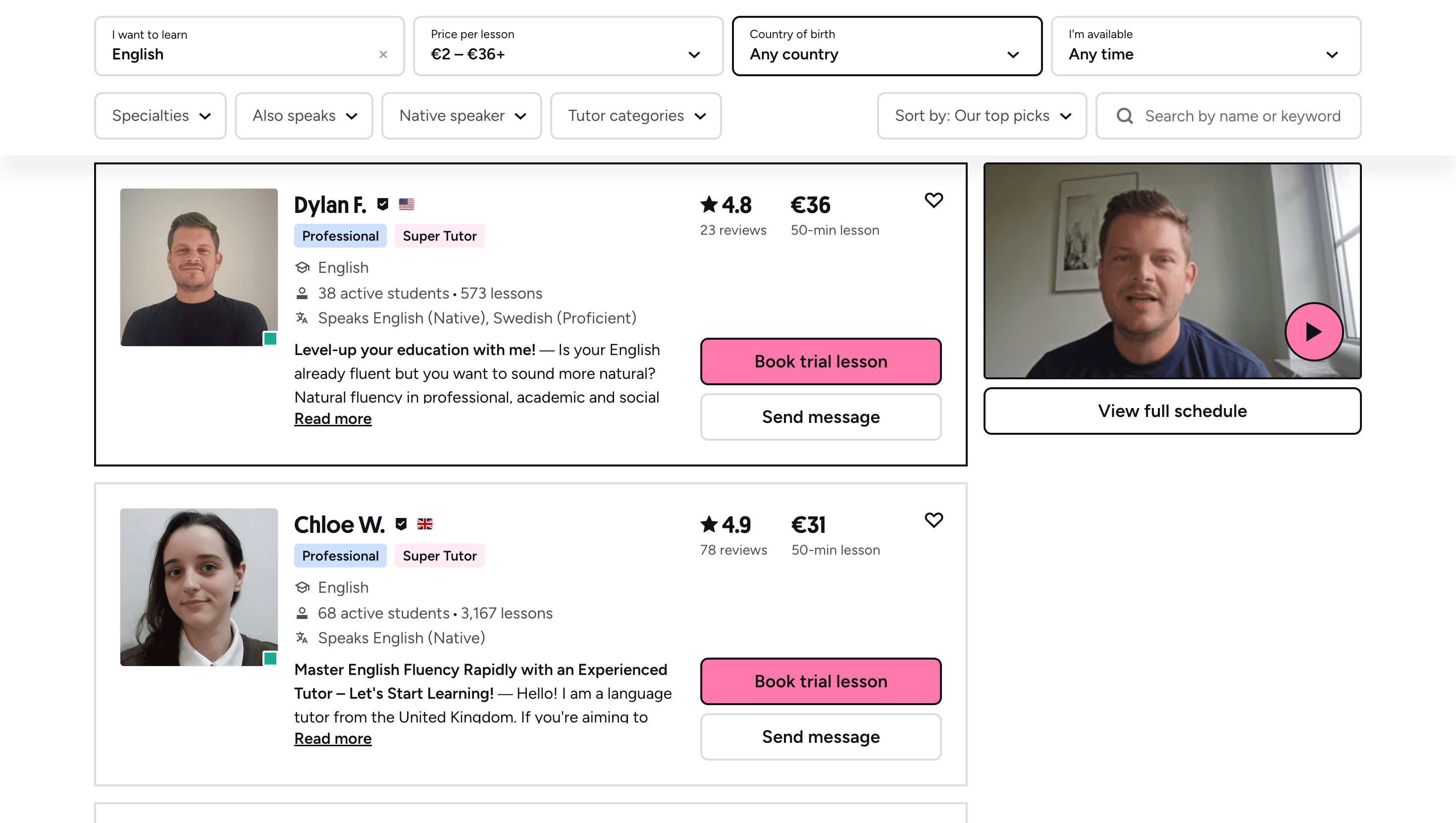
Many learners give up on language learning due to these high costs, missing out on valuable professional and personal opportunities.
That’s why we created Kylian: to make language learning accessible to everyone and help people master a foreign language without breaking the bank.
To get started, just tell Kylian which language you want to learn and what your native language is
Tired of teachers who don’t understand your specific struggles as a French speaker? Kylian’s advantage lies in its ability to teach any language using your native tongue as the foundation.
Unlike generic apps that offer the same content to everyone, Kylian explains concepts in your native language (French) and switches to the target language when necessary—perfectly adapting to your level and needs.
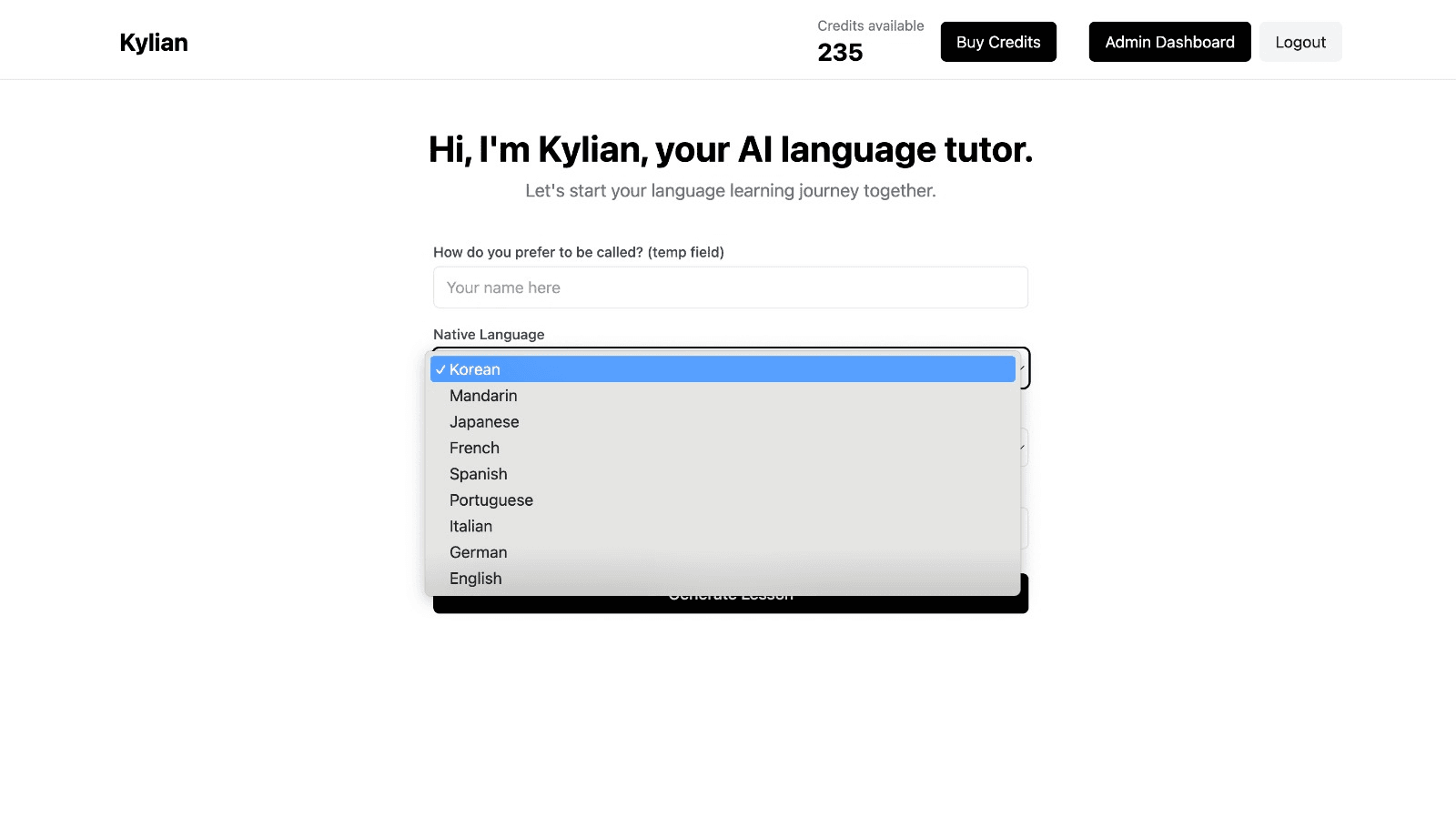
This personalization removes the frustration and confusion that are so common in traditional language learning.
Choose a specific topic you want to learn
Frustrated by language lessons that never cover exactly what you need? Kylian can teach you any aspect of a language—from pronunciation to advanced grammar—by focusing on your specific goals.
Avoid vague requests like “How can I improve my accent?” and be precise: “How do I pronounce the R like a native English speaker?” or “How do I conjugate the verb ‘to be’ in the present tense?”
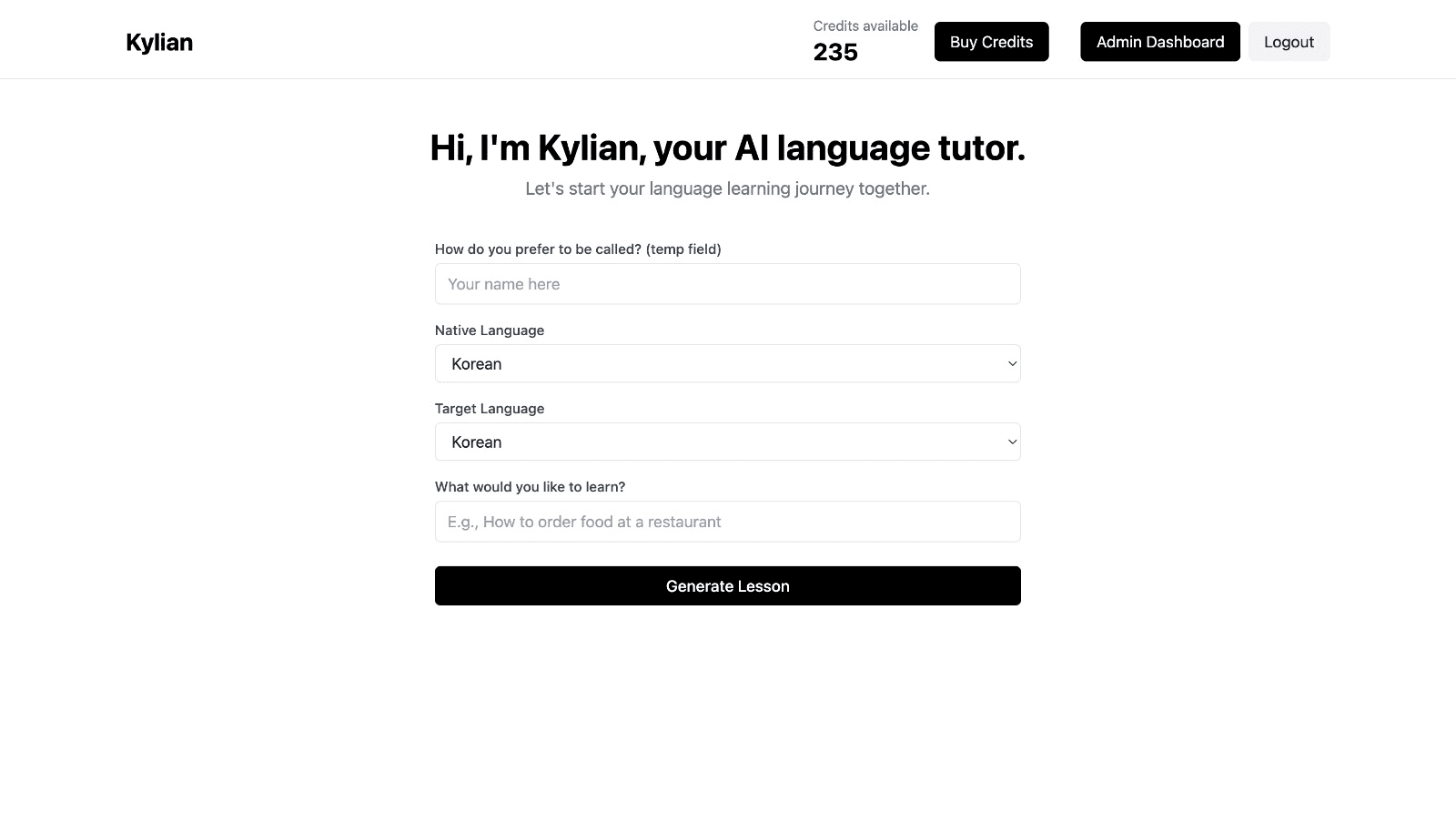
With Kylian, you’ll never again pay for irrelevant content or feel embarrassed asking “too basic” questions to a teacher. Your learning plan is entirely personalized.
Once you’ve chosen your topic, just hit the “Generate a Lesson” button, and within seconds, you’ll get a lesson designed exclusively for you.
Join the room to begin your lesson
The session feels like a one-on-one language class with a human tutor—but without the high price or time constraints.
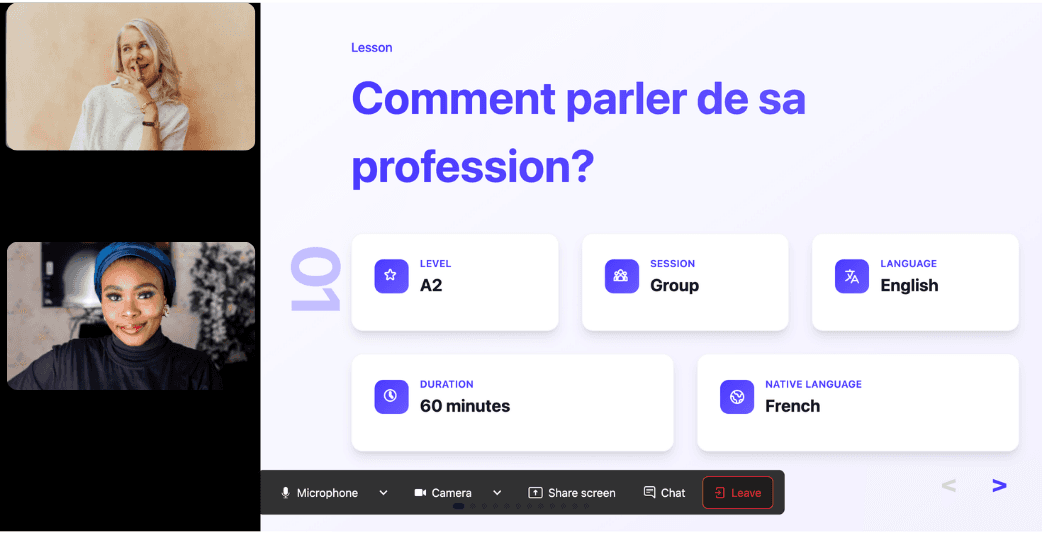
In a 25-minute lesson, Kylian teaches exactly what you need to know about your chosen topic: the nuances that textbooks never explain, key cultural differences between French and your target language, grammar rules, and much more.
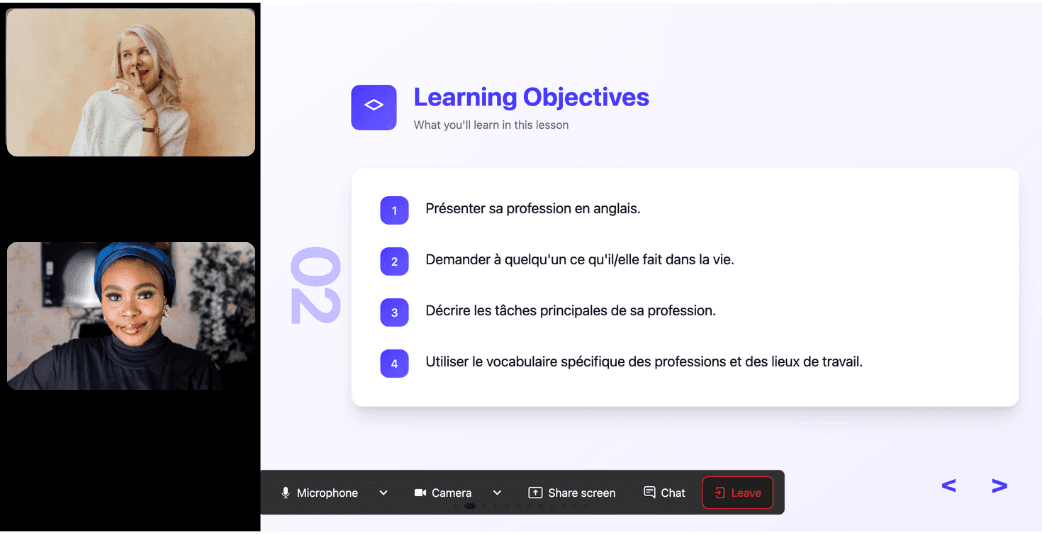
Ever felt frustrated trying to keep up with a native-speaking teacher, or embarrassed to ask for something to be repeated? With Kylian, that problem disappears. It switches intelligently between French and the target language depending on your level, helping you understand every concept at your own pace.
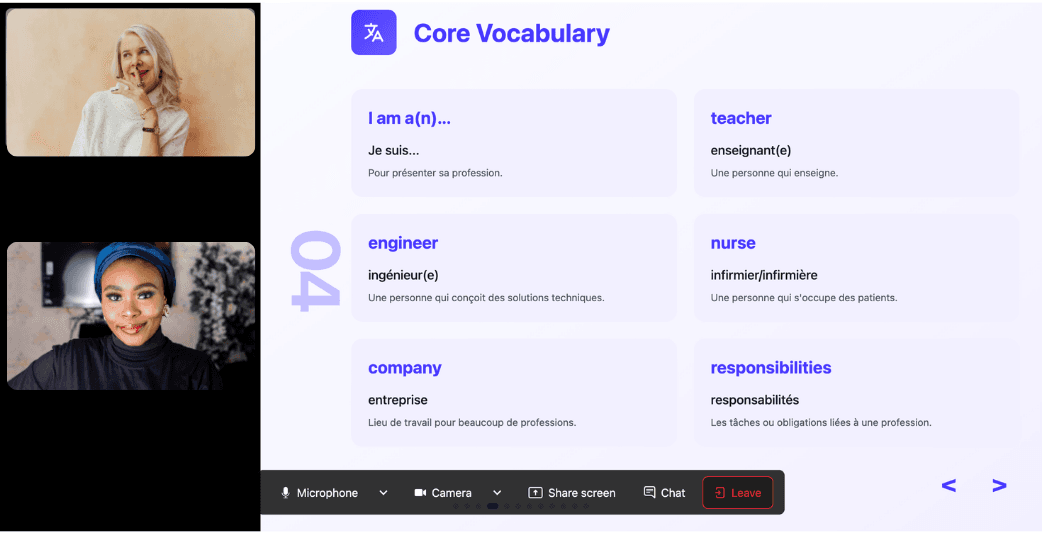
During the lesson, Kylian uses role-plays, real-life examples, and adapts to your learning style. Didn’t understand something? No problem—you can pause Kylian anytime to ask for clarification, without fear of being judged.
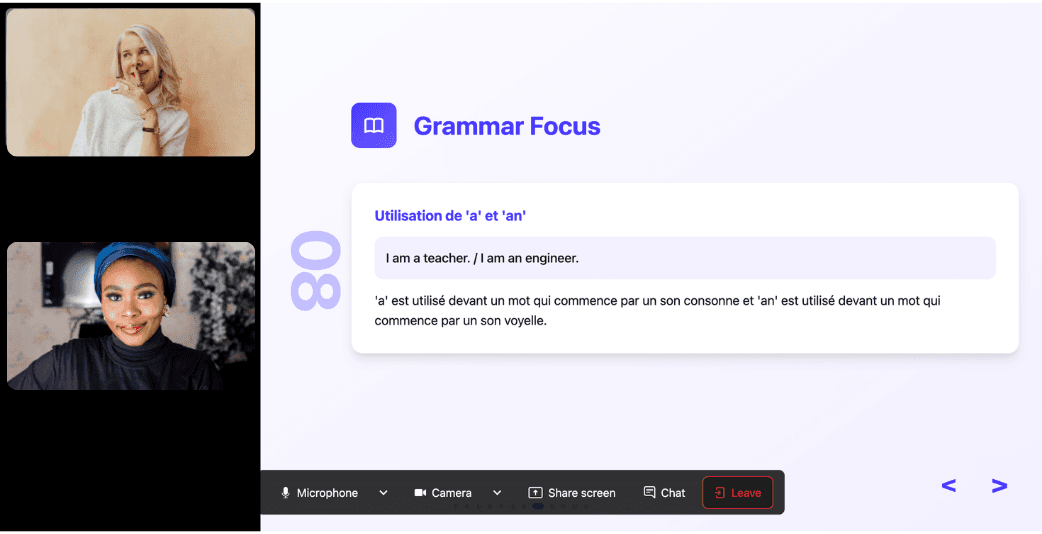
Ask all the questions you want, repeat sections if needed, and customize your learning experience in ways traditional teachers and generic apps simply can’t match.
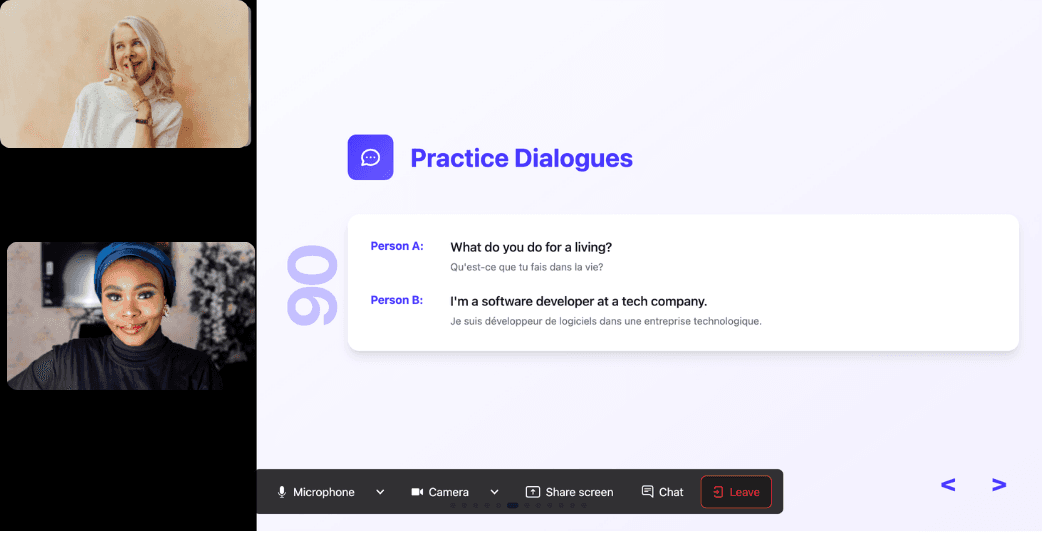
With 24/7 access at a fraction of the cost of private lessons, Kylian removes all the barriers that have kept you from mastering the language you’ve always wanted to learn.
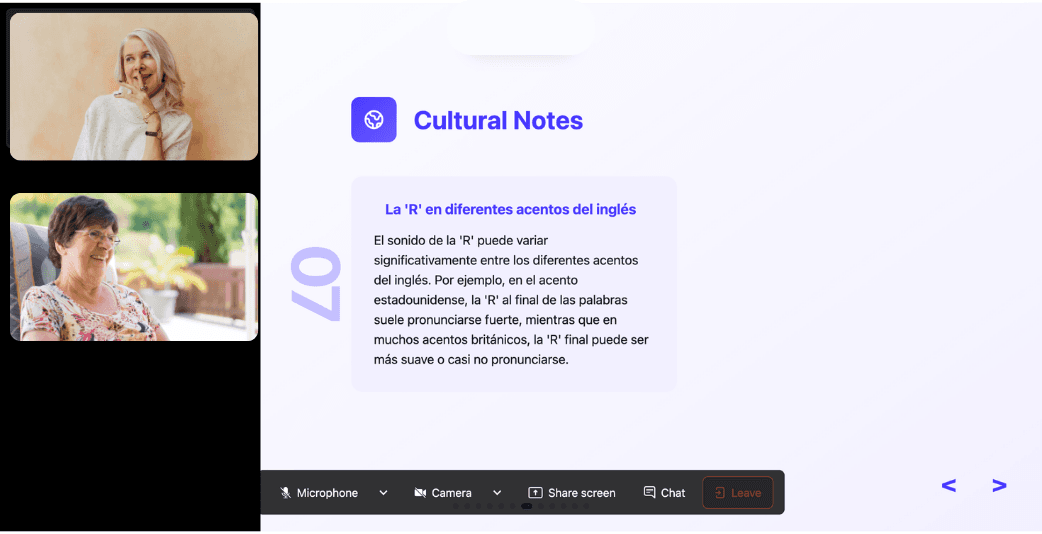
Similar Content You Might Want To Read

Mastering Chinese Birthday Wishes: The Complete Guide
Celebrating birthdays transcends cultural boundaries, yet the expressions and customs vary significantly across different societies. Understanding how to convey birthday wishes in Mandarin not only demonstrates cultural appreciation but also strengthens personal and professional relationships with Chinese speakers. This comprehensive guide will equip you with the linguistic tools and cultural context to properly celebrate birthdays in Chinese traditions.

"Nǐ hǎo!": The Guide to Chinese Greetings for Every Occasion
Learning to say "hello" in a new language opens doors to meaningful cultural exchanges. For those venturing into Mandarin Chinese, mastering greetings forms the foundation of communication. Whether you're planning a business trip to Shanghai, studying abroad in Beijing, or simply expanding your linguistic repertoire, understanding proper Chinese greetings will significantly enhance your interactions. While the ubiquitous 你好 "nǐ hǎo" (hello) serves as an all-purpose greeting, Mandarin offers a rich variety of contextual expressions that demonstrate cultural awareness and respect. This comprehensive guide explores greeting conventions for different times of day, social situations, and cultural celebrations—providing you with the linguistic tools to make genuine connections.

How to Learn Swedish: 10 Strategic Steps to Language Fluency
Swedish stands as a gateway to Scandinavian culture, opening doors to unprecedented opportunities for both personal and professional growth. As the most widely spoken North Germanic language, Swedish serves as a linguistic bridge connecting over 10 million speakers across Sweden and parts of Finland. What makes Swedish particularly appealing for English speakers is its Germanic roots—sharing vocabulary patterns, grammatical structures, and cultural references that create a surprisingly accessible learning path. Yet despite these advantages, mastering Swedish requires strategic approach and consistent practice. This comprehensive guide outlines ten evidence-based strategies that transform Swedish language acquisition from intimidating to achievable. Whether your motivation stems from career advancement, cultural immersion, or intellectual curiosity, these methods will establish a solid foundation for Swedish language proficiency.

15 Renowned Polyglots & Their Language Learning Wisdom
Ever wondered how some people master multiple languages with apparent ease? Like superheroes with linguistic superpowers, polyglots possess remarkable abilities that seem almost otherworldly. Yet unlike fictional characters, these language enthusiasts have real stories and practical advice worth exploring. The journey to multilingualism begins with curiosity—an intellectual spark that ignites a lifelong passion for languages. These extraordinary individuals weren't born speaking multiple tongues; they developed systematic approaches and mindsets that transformed language learning from daunting to achievable. Let's dive into the world of renowned polyglots and extract actionable wisdom from their experiences that can transform your own language learning journey.

Mastering the Plural Form of Gas in English
Language precision matters. When discussing scientific concepts, commercial products, or everyday phenomena, knowing the correct plural form of "gas" isn't merely academic—it's practical knowledge that impacts clear communication. The plural of "gas" presents a fascinating linguistic case study where context determines correctness. Many English learners and even native speakers hesitate when pluralizing "gas." Is it "gases," "gasses," or perhaps both? This article examines this question thoroughly, exploring the standard plural form, its variations, etymological origins, and practical applications across different contexts. Understanding these nuances enhances precision in both written and spoken English—a valuable skill for academics, professionals, and anyone seeking to communicate with clarity and confidence.

Laying Around or Lying Around: Understanding the Difference
The English language presents numerous challenges for learners and native speakers alike. Among these challenges, verb usage often tops the list of common mistakes. The confusion between "laying" and "lying" represents one of the most persistent grammatical mix-ups in everyday conversation and writing. This distinction matters because using the wrong form can fundamentally alter your intended meaning or simply mark your communication as imprecise. Why does this particular verbal confusion persist so stubbornly? The answer lies in the deceptive similarity between these two verbs and their overlapping past tense forms. For many English speakers, the proper usage remains elusive despite years of practice. This article aims to clarify this distinction once and for all, offering practical guidance that will eliminate this common error from your English repertoire.